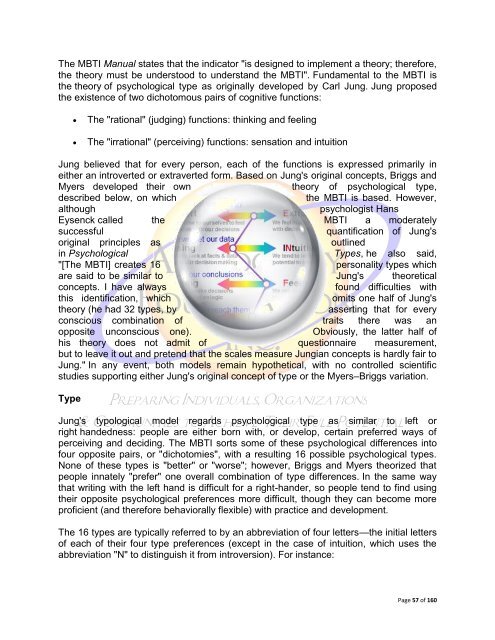The Gift of Introversion
The Gift of Introversion
The Gift of Introversion
You also want an ePaper? Increase the reach of your titles
YUMPU automatically turns print PDFs into web optimized ePapers that Google loves.
<strong>The</strong> MBTI Manual states that the indicator "is designed to implement a theory; therefore,<br />
the theory must be understood to understand the MBTI". Fundamental to the MBTI is<br />
the theory <strong>of</strong> psychological type as originally developed by Carl Jung. Jung proposed<br />
the existence <strong>of</strong> two dichotomous pairs <strong>of</strong> cognitive functions:<br />
<br />
<br />
<strong>The</strong> "rational" (judging) functions: thinking and feeling<br />
<strong>The</strong> "irrational" (perceiving) functions: sensation and intuition<br />
Jung believed that for every person, each <strong>of</strong> the functions is expressed primarily in<br />
either an introverted or extraverted form. Based on Jung's original concepts, Briggs and<br />
Myers developed their own theory <strong>of</strong> psychological type,<br />
described below, on which<br />
the MBTI is based. However,<br />
although<br />
psychologist Hans<br />
Eysenck called the MBTI a moderately<br />
successful<br />
quantification <strong>of</strong> Jung's<br />
original principles as outlined<br />
in Psychological Types, he also said,<br />
"[<strong>The</strong> MBTI] creates 16<br />
personality types which<br />
are said to be similar to Jung's theoretical<br />
concepts. I have always<br />
found difficulties with<br />
this identification, which<br />
omits one half <strong>of</strong> Jung's<br />
theory (he had 32 types, by<br />
asserting that for every<br />
conscious combination <strong>of</strong> traits there was an<br />
opposite unconscious one). Obviously, the latter half <strong>of</strong><br />
his theory does not admit <strong>of</strong> questionnaire measurement,<br />
but to leave it out and pretend that the scales measure Jungian concepts is hardly fair to<br />
Jung." In any event, both models remain hypothetical, with no controlled scientific<br />
studies supporting either Jung's original concept <strong>of</strong> type or the Myers–Briggs variation.<br />
Type<br />
Jung's typological model regards psychological type as similar to left or<br />
right handedness: people are either born with, or develop, certain preferred ways <strong>of</strong><br />
perceiving and deciding. <strong>The</strong> MBTI sorts some <strong>of</strong> these psychological differences into<br />
four opposite pairs, or "dichotomies", with a resulting 16 possible psychological types.<br />
None <strong>of</strong> these types is "better" or "worse"; however, Briggs and Myers theorized that<br />
people innately "prefer" one overall combination <strong>of</strong> type differences. In the same way<br />
that writing with the left hand is difficult for a right-hander, so people tend to find using<br />
their opposite psychological preferences more difficult, though they can become more<br />
pr<strong>of</strong>icient (and therefore behaviorally flexible) with practice and development.<br />
<strong>The</strong> 16 types are typically referred to by an abbreviation <strong>of</strong> four letters—the initial letters<br />
<strong>of</strong> each <strong>of</strong> their four type preferences (except in the case <strong>of</strong> intuition, which uses the<br />
abbreviation "N" to distinguish it from introversion). For instance:<br />
Page 57 <strong>of</strong> 160

















